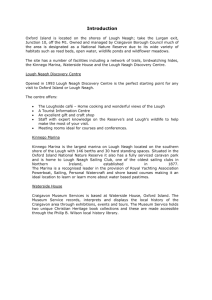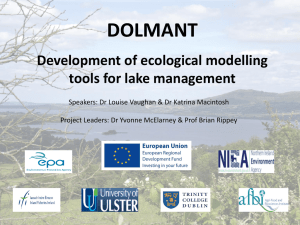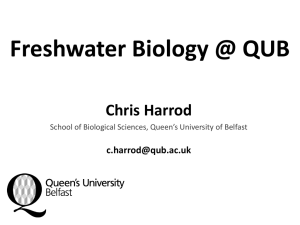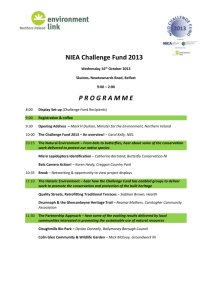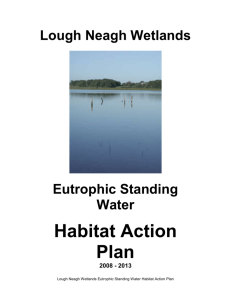4.8. Tree Sparrow Species Action Plan
advertisement
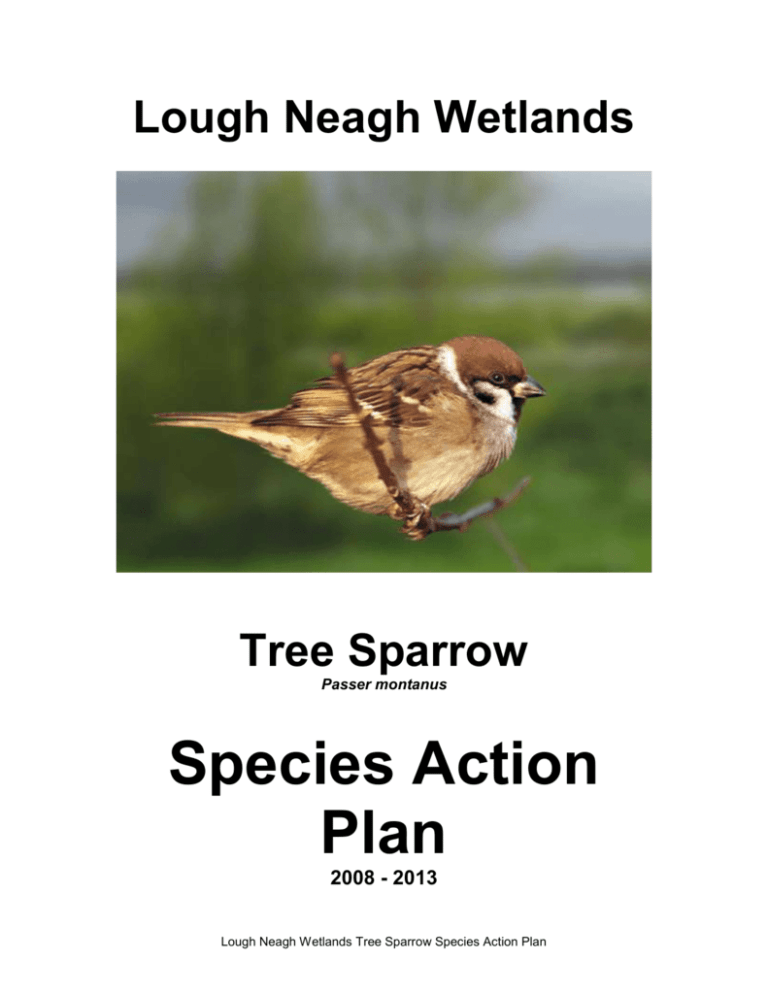
Lough Neagh Wetlands Tree Sparrow Passer montanus Species Action Plan 2008 - 2013 Lough Neagh Wetlands Tree Sparrow Species Action Plan Tree Sparrow in the Lough Neagh Wetlands Introduction The tree sparrow is a small brown bird with a rich chestnut brown head, clean white cheeks with a black spot and a white collar. It closely resembles a male house sparrow but the tree sparrow is slightly smaller, neater, lacks the grey crown, and has a smaller black bib which does not extend onto the breast. It has a stout seed-eating bill. They are found on farmland next to water-bodies and along waterways. In Northern Ireland, the stronghold for the population appears to be the Lough Neagh Wetlands where they occur around Lough Neagh, Lough Beg and Portmore Lough. Outside the wetlands, they occur on arable and mixed farmland in Co. Down and in other localised areas such as around Lough Foyle Background In the Lough Neagh Wetlands, tree sparrows nest in holes and will use old trees, the walls of old ruins and occupied buildings or even old sand martin burrows. They use a wide range of surrounding habitat for feeding. They will readily use nest boxes. The nest is an untidy mass of grasses and vegetation formed into a flattened dome. The breeding season extends from April to August when two or three broods are fledged. Each clutch consists of between 2 and 7 eggs and the chicks will be fed a wide range of invertebrates while they are in the nest. In summer, the adults also feed on a wide variety of invertebrates, while in winter, they feed on grain and weed seeds in cereal stubble fields, wild-bird cover and other seed-rich crops and grasses. They also take grain from feeding troughs intended for livestock. During winter, tree sparrows flock together and form mixed flocks with house sparrows and other seed-eating birds such as yellowhammers, and chaffinches. The tree sparrow has undergone a dramatic decline in population in the UK in recent decades, declining by 95% between 1970 and 1999. Its British range also decreased by 19.6% between the two Atlas periods 1968-72 and 1988-91. Current Breeding Bird Survey trends are unknown in Northern Ireland as not enough tree sparrows are detected to produce a reliable trend. The history of the species in Ireland has been one of decline and recovery. It was even extinct for a short time in the 1950s before recovering. The species is often known for its irruptive movements, which can lead to new colonies being formed on a local or wider scale. This irruptive behaviour is thought to have led to the re-colonization of Ireland in the 1950s. . Lough Neagh Wetlands Tree Sparrow Species Action Plan Threats Loss of feeding habitat Decline in winter stubble - The switch from mixed farming in Northern Ireland to specialisation in grass has meant fewer cereal stubble fields are left over the winter to provide seed food. The switch from spring – sown to autumn-sown cereal has also reduced the area of stubble available over the winter. Fewer weeds - Efficient harvesting methods and intensification of arable farming has meant that there is less spilt grain and fewer weeds to provide seeds and associated invertebrates. Increased herbicide and insecticide used directly has reduced the number of weed plants and invertebrates. Herbicides have also indirectly reduced invertebrates by removing the host plants on which they feed. As a result, tree sparrows have been left with reduced summer invertebrate food and reduced winter seed food. Loss of species-rich grassland - The intensification of grassland has caused the loss of species-rich grasslands, with intensive pasture and silage providing little in the way of seeds and invertebrates. Traditional, extensively managed meadows, rich in grasses and broadleaved herb species, are being reseeded with rye grass. Increased fertiliser inputs promote dense, rapid growth of uniform swards, low in structural and species diversity. Such swards are consequently heavily grazed or harvested for silage throughout the year. This creates a low diversity, highly disturbed environment containing few invertebrates. The grasses are rarely allowed to set-seed and so the seed resource never becomes available to the sparrows. Loss of invertebrate-rich habitats - Invertebrate-rich wet areas, ponds and open ditches have been filled in and drained. Cropped wet areas and seasonally used wet grazing areas have been drained, improved and put into crop or livestock production. These areas previously provided habitat for large bodied invertebrates, a favourite food supply of the tree sparrow. Non-cropped areas, rich in invertebrate life such as rough grass banks, uncultivated corners and un-cropped field margins have all been removed along with their valuable food source in order to increase the farmed area within the wetlands. Loss of nesting sites - Thick, well-managed hedges provide excellent roosting and nesting habitat. The loss of hedges through removal or lack of management reduces feeding opportunities for tree sparrows as they prefer to forage close to hedges that offer security from predators. Lough Neagh Wetlands Tree Sparrow Species Action Plan Loss of nesting sites A lack of traditional nesting sites such as holes in mature trees and buildings, and the loss of ruins and inappropriate management of old buildings could be limiting nesting opportunities for tree sparrows. The species readily utilizes new nesting boxes situated in suitable habitat. Such circumstances would suggest few other nesting sites are available in the vicinity. Opportunities Habitat creation Create feeding habitat such as stubble, wild bird cover, rough grass margins, near to water-bodies and along waterways Create/manage Invertebrate-rich wet areas, ponds and open ditches to provide accessibility to large bodied invertebrates Provide nesting boxes near suitable feeding habitat Provision of waste grain dumps inside old straw bales around field margins (linked to barn owl action plan) Habitat management Avoid re-seeding in areas containing high numbers of birds and where species-rich wet grassland exists Reduce use of herbicides / insecticides Target areas containing high numbers of birds, and areas targeted for expanding the population and aim to reduce the impact of herbicide and insecticide used to reduce the number of weed plants and invertebrates, to ensure tree sparrows can access summer invertebrate food and winter seed food. . Lough Neagh Wetlands Tree Sparrow Species Action Plan Tree Sparrow - Objectives & Targets Objectives & Targets OBJECTIVE TARGET TS/01 Confirm a baseline for the Lough Neagh Wetlands tree sparrow population 2008 TS/02 Maintain the existing Lough Neagh Wetlands population 2010 TS/03 Increase the Lough Neagh Wetlands population 2013 TS/04 Raise awareness of the habitat requirements of the tree sparrow 2013 Lough Neagh Wetlands Tree Sparrow Species Action Plan Lough Neagh Wetlands Tree Sparrow Species Action Plan Tree Sparrow - Action Actions ACTION LEAD PARTNER PARTNERS DARD / EHS / FWAG / LNAC / LNP / MDC / CDC / D&STBC / CBC / LCC / ABC / BCC DARD / EHS / FWAG / LNAC / LNP / MDC / CDC / D&STBC / CBC / LCC / ABC / BCC EHS / LNAC / LNP / MDC / CDC / D&STBC / CBC / LCC / ABC / BCC DARD / EHS / FWAG / LNAC / LNP / MDC / CDC / D&STBC / CBC / LCC / ABC / BCC EHS / LNP / MDC / CDC / D&STBC / CBC / LCC / ABC / BCC / RSPB LNAC / LNP / MDC / CDC / D&STBC / CBC / LCC / ABC / BCC TS/A1 Identify 14 sites containing tree sparrow colonies. Create and manage at least 42ha of suitable habitat (3 ha at each area). Target appropriate locations, near water bodies and waterways etc, and promote habitat creation and management. RSPB TS/A2 Strategically locate and operate 14 long-term winter supplementary feeding stations that are within range of existing breeding colonies in the Lough Neagh Wetlands RSPB TS/A3 Identify 7 sites that are suitable for the long-term monitoring of breeding and wintering tree sparrows and undertake monitoring of these selected areas once every three years to identify long-term population trends RSPB TS/A4 Develop suitable methodology for volunteers to monitor population levels of tree sparrows in the Lough Neagh Wetlands RSPB TS/A5 Set up a colour-ringng study of the tree sparrow in the Lough Neagh Wetlands to confirm the extent of local movement within the area in winter LNAC TS/A6 Produce interpretation material that promotes the importance of the Lough Neagh Wetlands as a stronghold for tree sparrows in Northern Ireland RSPB Lough Neagh Wetlands Tree Sparrow Species Action Plan TO BE ACHIEVED BY 31st Dec: 2008 OBJECTIVES MET TS/02 / TS/03 2008 TS/02 / TS/03 2008 TS/02 / TS/03 2008 TS/01 2008 TS/02 / TS/03 / TS/04 2008 TS/04 TS/A7 Promote the uptake of a Lough Neagh Wetlands Tree Sparrow Survey and encourage the general public to report sightings RSPB DARD / EHS / FWAG / LNAC / LNP / MDC / CDC / D&STBC / CBC / LCC / ABC / BCC DARD / EHS / FWAG / LNAC / LNP / MDC / CDC / D&STBC / CBC / LCC / ABC / BCC 2008 TS/04 TS/A8 Provide advisory materials to land managers, farmers and local authorities to encourage habitat creation and management for tree sparrows in the Lough Neagh Wetlands. RSPB 2008 TS/04 TS/A9 Undertake a study to confirm the habitat requirements of the tree sparrow in the Lough Neagh Wetlands, and use the results to target the future expansion of the population through appropriate agrienvironment options and other funding programmes RSPB DARD / EHS / LNAC / LNP / MDC / CDC / D&STBC / CBC / LCC / ABC / BCC 2009 TS/03 TS/A10 Collate information gathered during surveys and monitoring programmes and supply to the Lough Neagh Wetlands GIS and to CEDAR RSPB 2009 TS/01 TS/11 Undertake 2 surveys (1 every 3 years) to gauge the size and range of the breeding population of tree sparrow in the Lough Neagh Wetlands RSPB 2013 TS/O2 TS/A12 Raise awareness, on an annual basis, among agri-environment scheme advisors of the need to promote the take-up of appropriate agri-environment options that benefit tree sparrows LNAC DARD / EHS / LNAC / LNP / MDC / CDC / D&STBC / CBC / LCC / ABC / BCC LNAC/ EHS / LNP / MDC / CDC / D&STBC / CBC / LCC / ABC / BCC DARD / EHS / LNP / RSPB / MDC / CDC / D&STBC / CBC / LCC / ABC / BCC 2013 TS/04 Lough Neagh Wetlands Tree Sparrow Species Action Plan Lough Neagh Wetlands Tree Sparrow Species Action Plan
